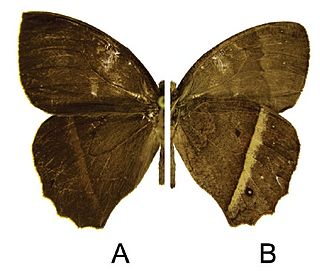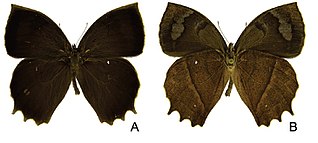
The Nymphalidae are the largest family of butterflies, with more than 6,000 species distributed throughout most of the world. Belonging to the superfamily Papilionoidea, they are usually medium-sized to large butterflies. Most species have a reduced pair of forelegs and many hold their colourful wings flat when resting. They are also called brush-footed butterflies or four-footed butterflies, because they are known to stand on only four legs while the other two are curled up; in some species, these forelegs have a brush-like set of hairs, which gives this family its other common name. Many species are brightly coloured and include popular species such as the emperors, monarch butterfly, admirals, tortoiseshells, and fritillaries. However, the under wings are, in contrast, often dull and in some species look remarkably like dead leaves, or are much paler, producing a cryptic effect that helps the butterflies blend into their surroundings.

The superfamily Papilionoidea contains all the butterflies except for the moth-like Hedyloidea.

The Satyrini is one of the tribes of the subfamily Satyrinae. It includes about 2200 species and is therefore the largest tribe in the subfamily which comprises 2500 species.

The Morphinae are a subfamily of Nymphalidae butterflies that includes the morphos, the owl butterflies (Caligo), and related lineages. It is either considered a sister group of the Satyrinae, or disassembled and included therein.

The Elymniini is one of the tribes of the subfamily Satyrinae. If the subfamily Satyrinae elevate to family status, this tribe shall be treated as subfamily Elymniinae. Elymniini was formerly a large group, but recently, it is considered to be include only one genus, Elymnias, according to molecular phylogenetic analyses.

The butterfly subtribe Euptychiina is a diverse group within the tribe Satyrini, occurring throughout Central and South America, in addition to a few species known from North America. Euptychiina is a predominantly lowland group, with the exception of one Asian taxon Palaeonympha opalinaButler, 1871 and the Andean genus ForsterinariaGray, 1973. The taxon was erected by Lee Denmar Miller.

Brassolini is a tribe usually placed in the brush-footed butterfly subfamily Morphinae, which is often included in the Satyrinae as a tribe Morphini. If this is accepted, the Brassolini become the sister tribe of the Morphini among the Satyrinae. Formerly, they were treated as an independent family Brassolidae or subfamily Brassolinae. Many members of this tribe are called owl butterflies.

Cithaerias is a Neotropical butterfly genus from the subfamily Satyrinae in the family Nymphalidae.

Pronophilina is a Neotropical subtribe of butterflies of the subfamily Satyrinae. They are a species-rich group with highest diversity in the tropical and subtropical mountains, especially the Andes. Before 1970, they were poorly studied, but recent interest has resulted in high rates of species description from previously unexplored mountain ranges. However, there is still a lack of knowledge on their biology and ecology. Their relationship to other groups of Satyrine butterflies and their complex patterns of speciation within and among mountain ranges have led to several biogeographic discussions.

Pedaliodes is a genus of butterflies from the subfamily Satyrinae in the family Nymphalidae found from Mexico to South America. The genus was erected by Arthur Gardiner Butler in 1867.

Taygetis is a genus of satyrid butterflies found in the Neotropical realm.
Taygetina peribaea is a species of butterfly in the subfamily Satyrinae. It is found in the Neotropical realm.
Guaianaza is a monotypic butterfly genus of the subfamily Satyrinae in the family Nymphalidae. Guaianaza is considered a synonym of the genus Forsterinaria Gray, 1973. Its single species, Guaianaza pronophila, is found in the Neotropical realm.
Prenda is a monotypic butterfly genus of subfamily Satyrinae in the family Nymphalidae. Its one species Prenda clarissa is found in the Neotropical realm.

Argyrophorus is a butterfly genus from the subfamily Satyrinae in the family Nymphalidae. It is distributed between Chile, Argentina and Perú. The systematic and circumscription of the genus is disputed.

Taguaiba servius is a species of butterfly of the family Nymphalidae. It is found in Brazil, where it has been recorded from Baixo Guandu in Espírito Santo and from Jitaúna in Bahia. It is probably also present in Minas Gerais.

Taguaiba drogoni is a species of butterfly of the family Nymphalidae. It is found in south-eastern Brazil in the states of Minas Gerais and São Paulo, at altitudes ranging from 800 to 1,500 meters.

Taguaiba rectifascia is a species of butterfly of the family Nymphalidae. It is found in the southeastern and southern Brazilian states of Rio de Janeiro, São Paulo, Paraná and Santa Catarina at altitudes ranging from 300 to 1,200 meters. It has also been found in other southeastern states of Brazil as well as in south western Ecuador.

Taguaiba ypthima is a species of butterfly of the family Nymphalidae. It is found in northeastern, southeastern and southern Brazil, Paraguay and Argentina at altitudes ranging from sea level to 2,000 metres (6,600 ft).

Carla Maria Penz is a butterfly comparative morphologist and systematist, and the Doris Zemurray Stone Chair in Biodiversity at the University of New Orleans. Her research also focuses on natural history and behavior, mostly of neotropical butterflies.
















